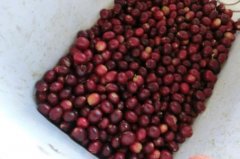A brief introduction to the coffee bean flavor and taste of Santa Rita Manor, Colombia.

Colombia is fortunate to have Atlantic and Pacific ports, which helps to reduce the cost of transporting coffee. In South America, she is the only country with this condition. The National Coffee Management Association of Colombia, like the National Management Association of Kenya, is a model of coffee organization. Compared with other producing countries, Colombia is more concerned with developing products and promoting production. It is this, coupled with its superior geographical and climatic conditions, that makes Colombian coffee excellent in quality and delicious and famous all over the world. The status of coffee in Colombia is illustrated by the fact that all vehicles entering the country must be sprayed and sterilized so as not to inadvertently cause disease and damage coffee trees.
The main production areas of Colombia are in the central and eastern mountains. The most important plantations along the central mountains are located in Medellin, Almenia and Manisales. Among the above three regions, Medellin has the best quality and high price of coffee, which is characterized by full granules, rich nutrition, rich aroma and moderate acidity. Taken together, these three areas are called MAM.
Colombian coffee is often described as having a silky taste. Of all the coffees, it has the best balance, soft and smooth taste, and can be drunk in more than 200 grades at any time, which means that the coffee is very regional. The country's coffee-producing areas are located in the Andes, where the climate is mild and the air is humid. Colombia has three Codiera mountains running north and south, right into the Andes. Coffee is grown along the highlands of these mountains. The mountain steps provide a diverse climate, where the whole year is the harvest season, and different kinds of coffee ripen at different times. And fortunately, unlike Brazil, Colombia doesn't have to worry about frost. About 700 million coffee trees are documented in Colombia, 66% of which are planted in modern plantations, while the rest are grown on small, traditionally run farms. In 1808, a priest first introduced coffee from the French Antilles to Colombia via Venezuela. Today, the country is the second largest coffee producer after Brazil, the world's largest exporter of Arabica coffee beans and the world's largest exporter of washed coffee beans.
Colombian coffee is one of the few original coffee sold in the world under the name of the country. In terms of quality, it has won praise unmatched by other coffee.
Important Notice :
前街咖啡 FrontStreet Coffee has moved to new addredd:
FrontStreet Coffee Address: 315,Donghua East Road,GuangZhou
Tel:020 38364473
- Prev

The first prize of the Panamanian national treasure bean cup test contest-Rosa
Maybe you don't know the story about rose summer, the fragrance of flowers, tropical fruit, strong sweetness; these are the feelings that rose summer has always brought to us. Properly baked, they make you feel like sipping the fragrance of a bouquet of flowers. It was originally a coffee sample that was brought to the coffee experimental garden in Costa Rica and distributed to several small farms.
- Next

A brief introduction to the planting of Coffee Flavor description varieties in Santa Rita Manor, Colombia
The main varieties of Colombian coffee are small grains of coffee. In 1864, Jubal A. Early led Confederate troops to occupy parts of Montgomery County for a short time and attack the District of Columbia. On July 11, Confederate troops attacked Rockville Pike (MD-355), New Cut Road (now Viers Mill Road MD-586) via Rockville and Wheaton.
Related
- Does Rose Summer choose Blue, Green or Red? Detailed explanation of Rose Summer Coffee plots and Classification in Panamanian Jade Manor
- What is the difference between the origin, producing area, processing plant, cooperative and manor of coffee beans?
- How fine does the espresso powder fit? how to grind the espresso?
- Sca coffee roasting degree color card coffee roasting degree 8 roasting color values what do you mean?
- The practice of lattes: how to make lattes at home
- Introduction to Indonesian Fine Coffee beans-- Java Coffee producing area of Indonesian Arabica Coffee
- How much will the flavor of light and medium roasted rose summer be expressed? What baking level is rose summer suitable for?
- Introduction to the characteristics of washing, sun-drying or wet-planing coffee commonly used in Mantenin, Indonesia
- Price characteristics of Arabica Coffee Bean Starbucks introduction to Manning Coffee Bean Taste producing area Variety Manor
- What is the authentic Yega flavor? What are the flavor characteristics of the really excellent Yejasuffi coffee beans?

